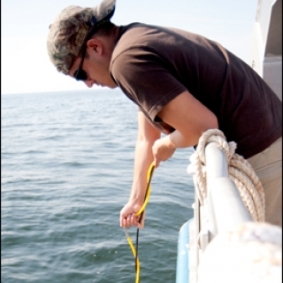Eight students will be presenting the summer work at the Ocean Sciences Meeting in March 2022!
Jason Emmel, Virginia Polytechnic Institute and State University
Class Year:
2010Mentor:
Lisa Kellogg, Ph.D.Project Title:
The Influence of Polychaetes and Amphipods on Denitrification Rates within Oyster Reef Communities
Abstract:
Excessive anthropogenic nutrient inputs from both point and non-point sources have contributed to a number of problems currently plaguing the Chesapeake Bay. Nitrogen compounds in particular have resulted in extremely high levels of phytoplankton production, causing hypoxia, and increased turbidity in certain parts of the Bay. In this study, we explore how denitrification rates may be influenced by processes that occur naturally within an oyster reef community. We conducted a three day laboratory experiment with sediment core samples to quantify nitrogen flux rates in the presence of two oyster reef associated organisms; polychaete worms (Alitta succinea) and amphipods (Leptocheirus plumulosus, Melita nitida, Gammarus spp., and Apocorophium spp.). Our results indicate a significant enhancement of denitrification rates in the presence of both polychaetes and amphipods, however, due to unforeseen influences within amphipod treatments, we were unable to attribute flux rates entirely to the treatment. We conclude that oyster reef communities with high densities of polychaetes and amphipods significantly enhance removal of nitrogen compounds.




